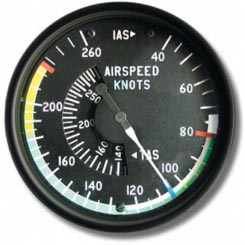Glossary of Aviation Terms | Airspeed
Airspeed | Paramount Business Jets
Airspeed is the speed of an aircraft relative to the air. This speed is measured inside the aircraft with an airspeed indicator, which is a device that can compute how fast the airplane is traveling. This device uses the ram-air pressure from instruments outside the aircraft and compares it to the non-moving air inside the vehicle. It then does a few calculations and gives the airspeed in several forms. There are different types of airspeed, like indicated, calibrated, equivalent, and true airspeed.
IAS, or Indicated Airspeed, is an instrument reading obtained from an airspeed indicator and is uncorrected for altitude, temperature, atmospheric density, or instrument error. Calibrated Airspeed is the airspeed after it is corrected for indicator, position, and installation errors, and is a little more realistic for the pilot to use.
Equivalent Airspeed is the speed at which the aircraft would currently be flying if it were at sea level. Airspeed between sea level and other elevations varies greatly due to the different air pressures at the two altitudes. Equivalent Airspeed corrects the indicated airspeed, and while not very useful to the pilot, a structural analyst may use Equivalent Airspeed in some calculations of aircraft dynamics.
True Airspeed is the airspeed of an aircraft relative to the air surrounding it, and is corrected for air pressure and temperature. This differs from equivalent airspeed because, instead of being calibrated for sea level flight, True Airspeed works with the air pressure currently surrounding the aircraft.

Explore More Aviation Terminology
- General Aviation District Office | Paramount Business Jets
- Layover | Paramount Business Jets
- Great Circle Distance | Paramount Business Jets
- Approach (Departure) Control | Paramount Business Jets
- Runway | Paramount Business Jets
- D-085 | Paramount Business Jets
- NBAA | Paramount Business Jets
- Part 91 | Paramount Business Jets
- ILS | Paramount Business Jets
